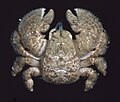Carcinisation (American English: carcinization) is a form of convergent evolution in which non-crab crustaceans evolve a crab-like body plan. The term...
20 KB (2,094 words) - 20:13, 6 June 2024
quite dissimilar. The group has been moulded by several instances of carcinisation – the development of a crab-like body form. Thus, the king crabs (Lithodidae)...
10 KB (796 words) - 05:13, 25 April 2024
have evolved features similar to true crabs through a process known as carcinisation. Crabs are found in all of the world's oceans, as well as in fresh water...
44 KB (4,506 words) - 07:20, 24 June 2024
property of "-phyly", which they assert applies only to groups of species. Carcinisation Convergent evolution Urry, Lisa A. (2016). Campbell Biology (11th ed...
11 KB (1,112 words) - 07:33, 9 February 2024
about this hypothesis, king crabs are the most widely quoted example of carcinisation among the Decapoda. The evidence for this explanation comes from the...
26 KB (2,266 words) - 04:03, 18 May 2024
Aegla. It is clear, however, that Lomis represents a separate case of carcinisation. The name "Lomidae" may also be encountered, but is incorrect. McLaughlin...
5 KB (413 words) - 21:18, 6 October 2023
size, or entirely absent. In both sexes, the uropods are biramous. Carcinisation has previously been explored in regards to outer morphology; however...
31 KB (3,831 words) - 00:24, 25 April 2024
early Pliensbachian of England, which lacked the crab-like morphology (carcinisation) of modern crabs, and Eoprosopon klugi from the late Pliensbachian of...
231 KB (24,881 words) - 03:13, 15 July 2024
is reduced and used for cleaning. Porcelain crabs are an example of carcinisation, whereby a noncrab-like animal (in this case a relative of a squat lobster)...
11 KB (938 words) - 01:15, 16 December 2022
might lead to the impression that convergent evolution has occurred. Carcinisation – Evolution of crustaceans into crab-like forms Morphology (biology) –...
56 KB (5,681 words) - 01:04, 25 June 2024
of around 20 millimetres (0.79 in). It displays an extreme form of carcinisation – evolution of a crab-like form – referred to as "hypercarcinisation"...
5 KB (448 words) - 17:12, 31 January 2022
Borradaile interpreted Porcellanopagurus as being an independent instance of carcinisation among the Anomura. Porcellanopagurus contains the following species:...
3 KB (212 words) - 01:54, 3 January 2024
known stem-group crab, but that it had not undergone the process of carcinisation. Sammy De Grave; N. Dean Pentcheff; Shane T. Ahyong; et al. (2009)....
4 KB (385 words) - 00:54, 2 September 2023
worked extensively on crabs and similar animals, and coined the term "carcinisation" to describe "one of the many attempts of Nature to evolve a crab"....
5 KB (439 words) - 18:14, 22 May 2024
true crab, but is now thought, like Platykotta, to show too little carcinisation to be a true crab, and is placed instead among the Anomura. Crustaceans...
4 KB (358 words) - 16:45, 23 January 2024
whirling drumsticks halteres that are used like gyroscopes in flight. Carcinisation: A crustacean evolves into a crab-like form from a non-crab-like form...
137 KB (14,866 words) - 19:17, 8 July 2024












